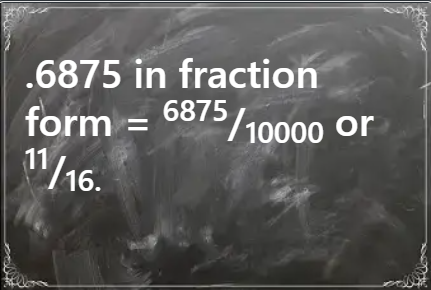Understanding Decimal Representation: Expressing .6875 in Fractional Clarity
When working with decimals, it is important to understand how they can be expressed in fractional form. Decimal numbers represent parts of whole numbers and fractions represent parts of a whole. In this section, we will delve into the process of converting the decimal number .6875 into its fractional equivalent for better clarity and understanding.
Decimal to Fraction Conversion: Exploring the Basics
Converting a decimal number into a fraction involves converting the decimal into a fraction with a denominator of 10, 100, 1000, etc. For instance, the decimal number .6875 can be represented as 6875/10000. To simplify this fraction, you can divide both the numerator and denominator by their greatest common factor, which in this case is 3125. This results in the simplified fraction 11/16.
Understanding the Fractional Representation of .6875
By expressing .6875 as the fraction 11/16, we can gain a better understanding of the relationship between the decimal and fractional forms of this number. The numerator, 11, represents the number of parts being considered, while the .6875 as a Fraction, 16, represents the total number of equal parts that make up a whole.
In fractional form, .6875 can be visualized as 11 out of 16 equal parts. This can be useful in various contexts, such as when working with measurements, cooking recipes, or any situation where fractional quantities are involved. Understanding the fractional representation of decimal numbers allows for more precise and accurate calculations.
Practical Applications: Using the Decimal to Fraction Calculator
To simplify the process of converting decimals into fractions, you can utilize the Ultimate Decimal to Fraction Calculator. This powerful tool can handle decimal numbers of any length and convert them into their fractional equivalents with ease. By inputting .6875 into the calculator, you will receive the fraction 11/16 in seconds.
The calculator also provides the option to simplify the fraction further, as we did earlier by dividing the numerator and denominator by their greatest common factor. This ensures that the fraction is in its simplest form, making it easier to work with in calculations or comparisons.
In addition to converting decimals into fractions, the calculator can also perform the reverse operation, converting fractions into decimals. This two-way functionality makes it a versatile tool for a wide range of mathematical tasks.
Conclusion
In conclusion, understanding decimal representation and converting them into fractions can provide clarity and precision in mathematical calculations. By expressing .6875 as the fraction 11/16, we can visualize the relationship between the decimal and fractional forms of this number. The Ultimate Decimal to Fraction Calculator serves as a valuable tool in simplifying this conversion process, enabling users to work with fractions more effectively. Whether you are a student, teacher, or a professional in a technical field, mastering decimal to fraction conversions is a valuable skill that can enhance your mathematical proficiency.




Comments
Post a Comment